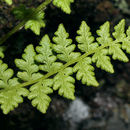Biology
provided by Arkive
Like all ferns, the oblong woodsia reproduces by producing spores instead of seeds. These spores develop a small green disc called a prothallus, which in turn produces the gametes. The gametes have to swim through water to reach each other in order to fuse and produce a new spore-bearing plant. The thinnest of films will do, but this reliance on water means the fern is limited to a habitat that remains wet or moist for at least part of the year.
Conservation
provided by Arkive
The oblong woodsia is listed in the UK Biodiversity Action Plans, and included in English Nature's Species Recovery Programme and Scottish Natural Heritage's Species Action Programme. All known populations are protected within Sites of Special Scientific Interest (SSSIs) and three are with National Nature Reserves (NNRs).
Attempts have begun to re-establish ex-situ populations. The Royal Botanic Gardens, Edinburgh, have grown sporelings collected under license from most of the wild sites in 1996. Plants have been reintroduced in Teesdale in the north of England, and in the southern uplands of Scotland, and these are being monitored each year to check the progress of the species recovery.
Description
provided by Arkive
This fern, thought to be Britain's rarest, is small in comparison with other members of its class. The variable-length leaves are a mid-green and their undersides are very hairy. The reddish-brown stalks are also hairy and covered in scales.
Habitat
provided by Arkive
This is a plant of tree-less, rocky habitats above 350 m, found growing in crevices in rock or on ledges in Britain, but in Europe it is found in woodland and even coastal areas.
Range
provided by Arkive
Oblong woodsia is common in Sweden and Norway and scattered across central Europe and Iceland. In the UK it is limited to five 10 km squares, with the largest colony in the Lake District and other populations in Scotland and Wales.
Status
provided by Arkive
Classified as Endangered in the UK.
Threats
provided by Arkive
Like the Killarney fern, oblong woodsia was a victim of the Victorian craze for collecting. It used to be thought that over-collecting was responsible for the plant's seeming inability to reproduce readily in the wild through a reduction in genetic viability. This is now believed to be untrue. The species is on the edge of its range in the UK and it is thought that the greatest threat to its survival here is climate change. With such isolated populations, there is little chance of the fern migrating to new sites should temperatures rise.

